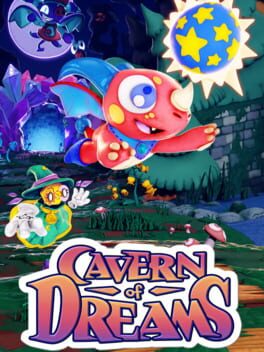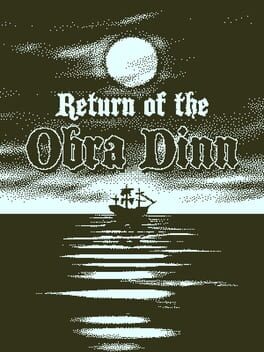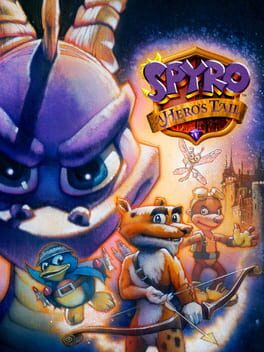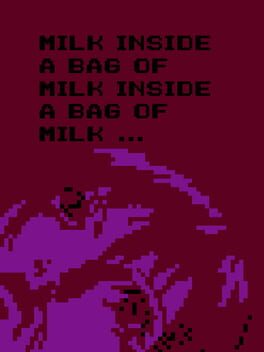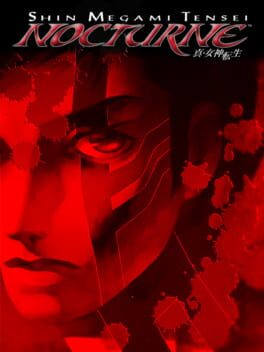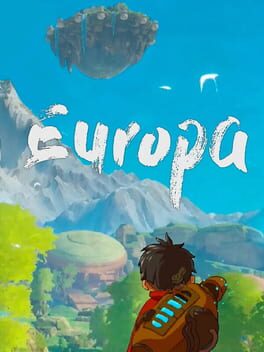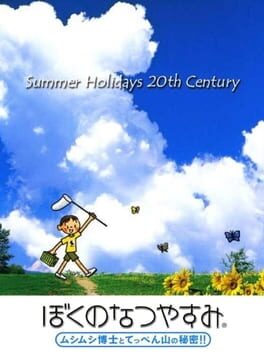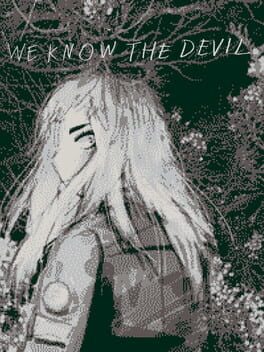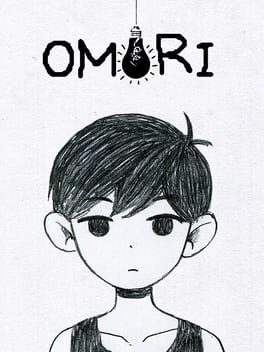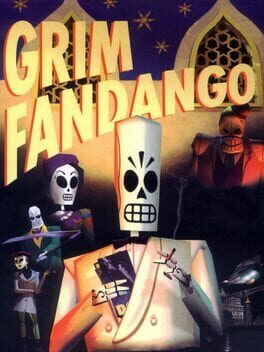KingofSushi
BACKER
166 reviews liked by KingofSushi
Super Mario World
1990
Super Mario 64
1996
Grimm's Hollow
2019
Realising that I'm a really big fan of the RPGmaker aesthetic because of games like this. I love looking at games and how they can be designed around certain constraints, seeing what interesting ideas are brought to the forefront to be conducive to both a great experience and one that doesn't compromise in its vision. In this case, it seems like the entire goal of the game was to craft an emotionally moving, character driven story while only having around 2 hours of gameplay, give or take, and I'd say that in this regard, Grimm's Hollow is a resounding success. The game is shockingly good at providing very clear and interesting pieces of characterisation that rapidly inject a lot of charm and colour into the world, all main characters having extremely clear and nuanced elements to their individual motives, a bunch of genuinely funny lines, just a bit of everything to give them just enough unique traits to feel distinct and interesting while still shrouding them in enough mystery to keep them intriguing, even once the game ends.
To add to this, the narrative in general is short yet very effective in its portrayal of attempting to process grief and everything that comes along with it in a variety of ways that naturally act as a way to ramp the tension and stakes. I love the way the music becomes so intense as things go on until it hits a point where it completely plateaus into a series of long winded, droning melodies that feel as if they represent the true reality of the situation setting in. Likewise, the use of colour feels pretty interesting, with the vaguely warm and cool colours of blue and purple being gradually phased out for a much harsher red, which cleverly manages to establish a much more intense feeling that once again feels as if it's then cleverly phased out to a more neutral series of greys and whites.
On top of the excellent, charming writing, I also really appreciated the combat once I got into it, being fairly simple and easy, but providing a lot of variety in what way you could choose to build your character and approach any given situation, having to carefully consider where to dump your resources for whatever potentially dangerous situation is ahead. The little timing based elements also kept it that bit fresher feeling, even if those mechanics were ultimately pretty shallow and felt as if they really should have had some nicer feedback associated with them to feel as polished as so many other elements here, but they did the trick enough to only rarely be a distraction. Overall this is just a really solid little game that does a lot with its short runtime and feels like an extremely well oiled machine with so much heart behind it. Definitely play this if you're at all into RPGmaker aesthetics or charming, occasionally quirky narrative experiences.
To add to this, the narrative in general is short yet very effective in its portrayal of attempting to process grief and everything that comes along with it in a variety of ways that naturally act as a way to ramp the tension and stakes. I love the way the music becomes so intense as things go on until it hits a point where it completely plateaus into a series of long winded, droning melodies that feel as if they represent the true reality of the situation setting in. Likewise, the use of colour feels pretty interesting, with the vaguely warm and cool colours of blue and purple being gradually phased out for a much harsher red, which cleverly manages to establish a much more intense feeling that once again feels as if it's then cleverly phased out to a more neutral series of greys and whites.
On top of the excellent, charming writing, I also really appreciated the combat once I got into it, being fairly simple and easy, but providing a lot of variety in what way you could choose to build your character and approach any given situation, having to carefully consider where to dump your resources for whatever potentially dangerous situation is ahead. The little timing based elements also kept it that bit fresher feeling, even if those mechanics were ultimately pretty shallow and felt as if they really should have had some nicer feedback associated with them to feel as polished as so many other elements here, but they did the trick enough to only rarely be a distraction. Overall this is just a really solid little game that does a lot with its short runtime and feels like an extremely well oiled machine with so much heart behind it. Definitely play this if you're at all into RPGmaker aesthetics or charming, occasionally quirky narrative experiences.
Cavern of Dreams
2023
got me thinking, among other things, about the various priorities the 3d platformer can take on...been playing this a bit in tandem with what is shaping up to be my first full playthru of mario 64 (and with sephonie as the most recent 3d platformer ive returned to) and i feel like they all illustrate some kind of imaginary rubric that u can place most of not all 3d platformers on. mario 64 here represents games that prioritize the Player Character above all else, famously slaved over for total perfection before a single real level was ever made...i'd say games like Demon Turf and Pseudoregalia pick up this torch the most. sephonie is for me the undisputed peak of the focus being the world itself, in a physical geometrical way...every move in ur toolkit is about interacting with specifically the space, u cant accomplish nearly as much in an empty room as u can with games in that first category. cavern of dreams then is a herald for games that mainly prioritize the world, but as Context rather then Shapes. its super super refreshing tbh...the spaces are about as far from abstraction as u can get despite how surreal and impossible they are. thinking about places and objects as Themselves are essential for solving the puzzles, which are the main focus here and an absolute delight...so many moments of realization were paired with a joyful smile. also super adorable and crittery, and vaguely disquieting but not in a way where it feels like its secretly threatening...all the colors are right there to be appreciated, its just strange to walk thru such expressionist worlds. an incredibly worthy successor to rareware platformers, which in retro terms were the kings of this kind of context-heavy approach (and in a slightly different way, story-driven adventure games like psychonauts). many of these indie 3d platformers take from the rareware lineage, corn kidz 64 also gave me a lot of banjo vibes, but all the games turn out so different! wonderful stuff, and extremely comforting game...v little high stakes platforming, just vibes and exploration and cool puzzles. also even tho this was a fairly easy 100%, its one of my favorites ive probably ever done...half of it gives u one of the coolest rewards EVER, the other half contains one of the coolest puzzles in the game...which ended up being the final card i needed, so it rly went out on a high note. and ofc, the whole game Expertly makes u feel like a Little Guy
A genuinely magical game that’s kept me thinking about it and will continue having this grip on me for quite some time. Games that utilise the medium to such an extent that their identity hinges on the interactive element being present are some of the most fun ones to let sit with you, and this is one of my favourite instances of it. Return of the Obra Dinn is one of the greatest mystery games I’ve played and a lot of this is owed to the structure of the game, forgoing crafting a mystery specifically designed to surprise the player with its various twists and instead laying it all out bare and forcing you to pick everything apart to fully grasp the finer details of things. The mystery and story themselves are not the important aspects here, it’s just trying to immerse you into the role of a detective without any handholding beyond the bare essentials, and it does so perfectly.
Return of the Obra Dinn is a mystery/puzzle game that revolves around incomplete information and assumption, often leaving little to no definitive evidence and forcing you to jump all around to place with increasingly tenuous lines of logic as you feel yourself going insane. It was quite funny taking a step back after combing through a few scenes in excruciating detail and just thinking “wow, this is deranged” but that’s just how the game is. The player is likely to find all of the story beats of the game rather early on without knowing the fates of the vast majority of the cast, and then the rest of the game boils down to going between the relevant scenes in the game to try and figure out how to deduce some of them, which would seem like an experience that would feel stagnant very quickly, but is saved due to the sense of progression that will take place despite it all just looking like cleanup at first. The progression gates in this game are entirely dependent on and driven by the player, hinging on multiple big realisations on how they need to approach their investigations. This culminates in a deeply rewarding loop of thinking that you’ve hit the logical endpoint of what you achieve on your own, before realising a new detail that leads you down a new line of logic to discover someone, and then applying this newfound understanding of how to figure something out to other characters. A contributing factor to how this is so successful is due to the plethora of approaches that you’re expected to work out, sometimes really being as simple but uncertain feeling as “this guy hangs around this other guy a lot, they’re probably in the same field”.
The way that your answers are confirmed is a clever way of limiting the ability to brute force a lot of puzzle answers as well, since you’ve only got confirmation on whether you’re correct or not once you have 3 correct answers simultaneously written down. While some amount of guesswork was an expected element of this game’s design, by structuring it like this, players are still forced to confidently deduce 2 other people before they can start taking real shots in the dark with incomplete assumptions, solving a problem I’ve seen time and time again in deduction games where people will often resort to total guesswork the moment they’re met with some confusion and uncertainty. The presentation goes a long way in tying everything together as well, being visually striking while having the effect of being simple enough to make the important details easier to pinpoint while simultaneously obscuring everything just enough to invite uncertainty into every observation. I adore whenever a game can keep me thinking for so long after I’m done with it, and I love it even more when it does so through something as esoteric as it is here. Total masterpiece, something new to add to my list of favourites.
Return of the Obra Dinn is a mystery/puzzle game that revolves around incomplete information and assumption, often leaving little to no definitive evidence and forcing you to jump all around to place with increasingly tenuous lines of logic as you feel yourself going insane. It was quite funny taking a step back after combing through a few scenes in excruciating detail and just thinking “wow, this is deranged” but that’s just how the game is. The player is likely to find all of the story beats of the game rather early on without knowing the fates of the vast majority of the cast, and then the rest of the game boils down to going between the relevant scenes in the game to try and figure out how to deduce some of them, which would seem like an experience that would feel stagnant very quickly, but is saved due to the sense of progression that will take place despite it all just looking like cleanup at first. The progression gates in this game are entirely dependent on and driven by the player, hinging on multiple big realisations on how they need to approach their investigations. This culminates in a deeply rewarding loop of thinking that you’ve hit the logical endpoint of what you achieve on your own, before realising a new detail that leads you down a new line of logic to discover someone, and then applying this newfound understanding of how to figure something out to other characters. A contributing factor to how this is so successful is due to the plethora of approaches that you’re expected to work out, sometimes really being as simple but uncertain feeling as “this guy hangs around this other guy a lot, they’re probably in the same field”.
The way that your answers are confirmed is a clever way of limiting the ability to brute force a lot of puzzle answers as well, since you’ve only got confirmation on whether you’re correct or not once you have 3 correct answers simultaneously written down. While some amount of guesswork was an expected element of this game’s design, by structuring it like this, players are still forced to confidently deduce 2 other people before they can start taking real shots in the dark with incomplete assumptions, solving a problem I’ve seen time and time again in deduction games where people will often resort to total guesswork the moment they’re met with some confusion and uncertainty. The presentation goes a long way in tying everything together as well, being visually striking while having the effect of being simple enough to make the important details easier to pinpoint while simultaneously obscuring everything just enough to invite uncertainty into every observation. I adore whenever a game can keep me thinking for so long after I’m done with it, and I love it even more when it does so through something as esoteric as it is here. Total masterpiece, something new to add to my list of favourites.
Spyro: A Hero's Tail
2004
This was one of THE games of my childhood so I was excited to get back around to it and see if I still felt like it held up to an extent when returning to it, and I was pretty amazed with how much of this game feels almost as if it was tailor made to feel like the biggest, most exciting thing ever to a kid. Looking at it now, there’s definitely quite a bit that doesn’t really work too well, and it feels more like a typical 5th gen platformer than something that is uniquely Spyro, but even so, I can see why I was obsessed with this game when I was younger, and it was still quite fun to me this time, especially since I realised that I remembered almost nothing about it whatsoever.
The way that this game mainly stands out to me is with how it utilises negative space in its stages, often having these large, open unreachable spaces that stretch over the horizon, not really having much in them, but providing a sense of scale and sparseness to each world. This trait is consistently one of the most enchanting things to me in a 3D platformer when handled correctly, and it’s done marvellously here, with a lot of the biggest points of spectacle in the stages being these moments where walking through the claustrophobic corridors and gauntlets leads you to a big, open area, often with level boundaries that don’t do much to visually cover up the emptiness behind them, which in turn evokes a similar atmosphere to Stone Hill from Spyro 1, just in far more locations. What really sells the game’s visuals to me is how it does all this while maintaining a sense of lushness and vibrancy to even the most hostile of locations, making places like the swamp still look strangely warm and inviting.
Switching up the structure of the game from self-contained levels to larger, interconnected zones is another way that the game felt so massive to me as a kid, with the relatively seamless transitions making those sudden changes in scenery feel all the more impactful. A more open approach to level design felt like the natural progression of the series as a whole as well thanks to how Spyro’s mobility options have always differed to a typical 3D platformer, and it’s handled rather well here purely in terms of how each areas feels to exist in. Unfortunately, it becomes clear very quickly that outside of the atmosphere, A Hero’s Tail doesn’t really know how to fully utilise the tools at its disposal and dumbs things down a lot in places that could have been where the game shone the brightest. The way collectibles are hidden is the biggest way this becomes so apparent, with the majority of them being more or less directly in sight of the player and just requiring very short, easy platforming challenges to reach them. It rarely feels as if you’re actively exploring the levels as a result, instead doing something more akin to being led down a bunch of paths that are very clearly signposted for your convenience, feeling closer to a theme park attraction than a proper platforming stage in places. This makes the actual exploration of the stages feel very barebones, something that is only saved due to how beautiful they all are and the fact that the occasional instances of genuinely well-hidden stuff feel like fantastic curveballs, regardless of how few and far between they may be.
Unfortunately, I also don’t quite love how certain aspects of Spyro’s controls feel in this game, especially with how jumping works. You have a double jump in this, but it’ll only trigger before and at the exact moment where you hit the peak in your jump, and afterwards will be a glide instead. This feels really rough in the more technical platforming sections, since the typical strategy of waiting a bit longer before jumping again so you can extend the distance will just kill you here instead, setting things up in such a way that you always feel like you’re jumping a bit too early, even if you still get to where you need to. None of Spyro’s moves flow into one another smoothly enough to make the moment to moment experience feel quite annoying because of it. Hitboxes also come across as very iffy sometimes, particularly whenever there’s something you need to pole spin across, as it’s a common occurrence for you to phase through these if you didn’t hit the exact trigger point, often leading to death. Boss fights are consistently a low point of the game as well, consisting of a lot of waiting in between attack cycles for the one moment where you can hit them, often with attacks worked in that don’t feel designed with consistent dodging in mind, leading to some real cheap shots that are irritating every time, even if they rarely lead to an outright death.
While the Spyro gameplay is largely a very pleasant ride, despite its simplicity and problems (it’s a kids game and a good one at that, it’s allowed to be simple), my praise for almost everything outside of Spyro’s portion of the game runs far thinner. Rather than taking the approach of Spyro 2, 3 and even Enter the Dragonfly to a lesser extent, where there was a constant bombardment of weird game modes that would only appear once or twice and make each place stand out simply due to how many different ideas could be packed into each twist and turn, a Hero’s Tail opts to largely contain it to 5 different additional game modes that all make an appearance in each world instead. To give some credit to this concept, a lot of this adds a greater sense of liveliness to the world, with Sgt Byrd’s speedways, Sparx’s shooter sections and Blink’s underground expeditions showcasing different facets of the world, making the skies, the underground and even small gaps within the walls feel populated. Unfortunately, most of these additional gameplay sections play very poorly and break up the pacing in a truly horrible way.
The Sgt Byrd sections are the best parts of the game’s side content, acting as the speedway sections from the previous games, just with a couple of key twists that switch things up, both for better and for worse. The jetpack controls feels a bit different to how Spyro would fly in the past games, but ends up working out nicely, making things feel quick and weighty, with the ability to use fuel to boost further contributing to this. The ability to fire off your homing rocket launchers and have them come into contact with something as long as they’re vaguely on screen is an aspect I’m less appreciative of, as it leads to the player having to think less about routing and how to efficiently grab everything. None of these speedways took more than one or two attempts each and they’d always feel like a bit of a blur, where I’d just fly around and hit stuff aimlessly until I’d eventually win. The most difficult parts of each of these was just finding those last one or two objectives that had been tucked away somewhere, rather than having to understand the stage as a whole. Despite my issues, these end up being quite fun regardless, it’s just that they miss out on a lot of smaller details that made these always feel so exciting in the original trilogy.
In contrast to this, the other 4 main modes all kinda suck for the most part. The turret sections of each world just scream “this was a 5th gen platformer so we needed a few of these”, and feel like a mindless distraction, they feel gimmicky, and unlike the skateboard sections in Year of the Dragon, do not have enough time put into them to feel like a fun distraction, just an obligation and a hollow attempt at spicing up gameplay. The Sparx sections similarly feel utterly skeletal in how little is going on here, just being a bland rail shooter, with the caveat being that he takes up so much of the screen that properly navigating between threats is an obnoxious endeavour. The ball sections start off well enough, with the introductory one being a fun obstacle course with a bit of exploration and moments where the level design gets a bit playful with the physics, but the other 2 appearances of this in the game are far more on rails, either being a janky marble run section that has a tendency to throw you into bottomless pits constantly, or a minecart section with obstacles that come out of nowhere. The Blink the mole sections are where the game is at its worst however. These sections are entirely built around being stealthy, and cycle-based platforming, with each cycle being agonisingly slow to the point where each of these 4 stages will make you spend at least half of the time either waiting for an obvious opportunity to proceed, or slowly traversing via walls, ceilings or by standing on glacial moving platforms. Adding insult to injury is the way that all of these minigames require you to go through them twice if you want all of the collectibles, and while they’re technically harder than they were the first time, the changes are always so minimal that you might as well just be doing the same thing a 2nd time.
This is a game with a lot of issues for sure, but it’s a lovely time nonetheless. No amount of frustrating, tedious minigame nonsense will take away from the fact that the atmosphere and scenery of A Hero’s Tail is downright breathtaking (and trust me, the game really seems to want to see how much dumb garbage it can get away with packing into this). A very cute, pleasant experience that I would recommend to those who enjoyed the original trilogy, it’s not quite as good in my opinion, but it’s got its own appeal all the same, just maybe don’t try going for all collectibles, you’ll enjoy it more that way.
The way that this game mainly stands out to me is with how it utilises negative space in its stages, often having these large, open unreachable spaces that stretch over the horizon, not really having much in them, but providing a sense of scale and sparseness to each world. This trait is consistently one of the most enchanting things to me in a 3D platformer when handled correctly, and it’s done marvellously here, with a lot of the biggest points of spectacle in the stages being these moments where walking through the claustrophobic corridors and gauntlets leads you to a big, open area, often with level boundaries that don’t do much to visually cover up the emptiness behind them, which in turn evokes a similar atmosphere to Stone Hill from Spyro 1, just in far more locations. What really sells the game’s visuals to me is how it does all this while maintaining a sense of lushness and vibrancy to even the most hostile of locations, making places like the swamp still look strangely warm and inviting.
Switching up the structure of the game from self-contained levels to larger, interconnected zones is another way that the game felt so massive to me as a kid, with the relatively seamless transitions making those sudden changes in scenery feel all the more impactful. A more open approach to level design felt like the natural progression of the series as a whole as well thanks to how Spyro’s mobility options have always differed to a typical 3D platformer, and it’s handled rather well here purely in terms of how each areas feels to exist in. Unfortunately, it becomes clear very quickly that outside of the atmosphere, A Hero’s Tail doesn’t really know how to fully utilise the tools at its disposal and dumbs things down a lot in places that could have been where the game shone the brightest. The way collectibles are hidden is the biggest way this becomes so apparent, with the majority of them being more or less directly in sight of the player and just requiring very short, easy platforming challenges to reach them. It rarely feels as if you’re actively exploring the levels as a result, instead doing something more akin to being led down a bunch of paths that are very clearly signposted for your convenience, feeling closer to a theme park attraction than a proper platforming stage in places. This makes the actual exploration of the stages feel very barebones, something that is only saved due to how beautiful they all are and the fact that the occasional instances of genuinely well-hidden stuff feel like fantastic curveballs, regardless of how few and far between they may be.
Unfortunately, I also don’t quite love how certain aspects of Spyro’s controls feel in this game, especially with how jumping works. You have a double jump in this, but it’ll only trigger before and at the exact moment where you hit the peak in your jump, and afterwards will be a glide instead. This feels really rough in the more technical platforming sections, since the typical strategy of waiting a bit longer before jumping again so you can extend the distance will just kill you here instead, setting things up in such a way that you always feel like you’re jumping a bit too early, even if you still get to where you need to. None of Spyro’s moves flow into one another smoothly enough to make the moment to moment experience feel quite annoying because of it. Hitboxes also come across as very iffy sometimes, particularly whenever there’s something you need to pole spin across, as it’s a common occurrence for you to phase through these if you didn’t hit the exact trigger point, often leading to death. Boss fights are consistently a low point of the game as well, consisting of a lot of waiting in between attack cycles for the one moment where you can hit them, often with attacks worked in that don’t feel designed with consistent dodging in mind, leading to some real cheap shots that are irritating every time, even if they rarely lead to an outright death.
While the Spyro gameplay is largely a very pleasant ride, despite its simplicity and problems (it’s a kids game and a good one at that, it’s allowed to be simple), my praise for almost everything outside of Spyro’s portion of the game runs far thinner. Rather than taking the approach of Spyro 2, 3 and even Enter the Dragonfly to a lesser extent, where there was a constant bombardment of weird game modes that would only appear once or twice and make each place stand out simply due to how many different ideas could be packed into each twist and turn, a Hero’s Tail opts to largely contain it to 5 different additional game modes that all make an appearance in each world instead. To give some credit to this concept, a lot of this adds a greater sense of liveliness to the world, with Sgt Byrd’s speedways, Sparx’s shooter sections and Blink’s underground expeditions showcasing different facets of the world, making the skies, the underground and even small gaps within the walls feel populated. Unfortunately, most of these additional gameplay sections play very poorly and break up the pacing in a truly horrible way.
The Sgt Byrd sections are the best parts of the game’s side content, acting as the speedway sections from the previous games, just with a couple of key twists that switch things up, both for better and for worse. The jetpack controls feels a bit different to how Spyro would fly in the past games, but ends up working out nicely, making things feel quick and weighty, with the ability to use fuel to boost further contributing to this. The ability to fire off your homing rocket launchers and have them come into contact with something as long as they’re vaguely on screen is an aspect I’m less appreciative of, as it leads to the player having to think less about routing and how to efficiently grab everything. None of these speedways took more than one or two attempts each and they’d always feel like a bit of a blur, where I’d just fly around and hit stuff aimlessly until I’d eventually win. The most difficult parts of each of these was just finding those last one or two objectives that had been tucked away somewhere, rather than having to understand the stage as a whole. Despite my issues, these end up being quite fun regardless, it’s just that they miss out on a lot of smaller details that made these always feel so exciting in the original trilogy.
In contrast to this, the other 4 main modes all kinda suck for the most part. The turret sections of each world just scream “this was a 5th gen platformer so we needed a few of these”, and feel like a mindless distraction, they feel gimmicky, and unlike the skateboard sections in Year of the Dragon, do not have enough time put into them to feel like a fun distraction, just an obligation and a hollow attempt at spicing up gameplay. The Sparx sections similarly feel utterly skeletal in how little is going on here, just being a bland rail shooter, with the caveat being that he takes up so much of the screen that properly navigating between threats is an obnoxious endeavour. The ball sections start off well enough, with the introductory one being a fun obstacle course with a bit of exploration and moments where the level design gets a bit playful with the physics, but the other 2 appearances of this in the game are far more on rails, either being a janky marble run section that has a tendency to throw you into bottomless pits constantly, or a minecart section with obstacles that come out of nowhere. The Blink the mole sections are where the game is at its worst however. These sections are entirely built around being stealthy, and cycle-based platforming, with each cycle being agonisingly slow to the point where each of these 4 stages will make you spend at least half of the time either waiting for an obvious opportunity to proceed, or slowly traversing via walls, ceilings or by standing on glacial moving platforms. Adding insult to injury is the way that all of these minigames require you to go through them twice if you want all of the collectibles, and while they’re technically harder than they were the first time, the changes are always so minimal that you might as well just be doing the same thing a 2nd time.
This is a game with a lot of issues for sure, but it’s a lovely time nonetheless. No amount of frustrating, tedious minigame nonsense will take away from the fact that the atmosphere and scenery of A Hero’s Tail is downright breathtaking (and trust me, the game really seems to want to see how much dumb garbage it can get away with packing into this). A very cute, pleasant experience that I would recommend to those who enjoyed the original trilogy, it’s not quite as good in my opinion, but it’s got its own appeal all the same, just maybe don’t try going for all collectibles, you’ll enjoy it more that way.
Balan Wonderworld
2021
If there was one typically maligned game that I had expected to get more out of than the average person, it would’ve been this one, after all, it’s a colourful 3D platformer with a lot of weird ideas thrown into the mix. The amount of discussion surrounding such games to make them purely out as these punching bags to point and laugh at in bad faith is a tiresome thing to witness time and time again and my hatred for such a mindset is ultimately one of the many reasons why I strive to approach art with optimism. Unfortunately, while I definitely think I have a bit more appreciation for this than I often see, there’s a bit too much about Balan Wonderworld that is downright baffling to me, which when combined with how utterly milquetoast other elements of the game are, makes for a very stilted experience that never fully achieves the grander heights that it’s going for.
I think that the one button control scheme that the game goes for is one of the biggest missed opportunities here, as a lot of the groundwork for something really cool is in place, but the level design simply isn’t strong enough to accommodate for the weird ideas in play. There are over 60 costumes in the game, and due to the simplistic controls, each of these will only have one function, with an occasional 2nd one that will be activated in a less conventional way, and unfortunately, jumping counts as a function, so in this platformer game, you’ll be in situations at times where you’re unable to jump. This isn’t as inherently bad as it may seem, but the level design doesn’t seem to be thoughtfully designed around the potential limitations that the player will face. Another aspect that doesn’t help is that even though there are so many costumes with a lot of different effects, a solid chunk of these exist to interact in a very lock and key way with the environment, having only one specific use that’s blatantly stated, with no way of utilising it in any other ways. This results in a lot of costumes feeling extremely underwhelming to unlock, as you know that the only thing it’ll be good for is to open the paths in specifically designated areas, making it feel functionally worthless and boring in any other scenario.
Adding to the frustration is that getting hit a single time will make you entirely lose the costume you’re wearing, forcing you to go and recollect it if you want to use it again. This doesn’t really do anything beyond add a layer of tedium to it all, since it’s not like it even returns to an inventory or anything, it’s just gone. This feeds back into the frustration with not being able to consistently jump, depending on your costume loadout, since taking a hit can straight up leave you in a situation where you need to backtrack and grab another costume since you can’t progress otherwise. Despite my issues however, there’s definitely something here with the idea in its current form, it’s offbeat for sure, but not a totally lost cause either. Rather than crafting each stage to feel like the most barebones, basic 3D platformer stuff out there, the game would work a whole lot better if there were a bunch of different, branching paths within the stages that took advantage of specific abilities, or at least multiple ways to reach the same location so as to not completely lock you out of progression by getting hit once and still contribute to a sense of exploration, as a collectathon should feature in some capacity. This would lead to a more varied set of obstacles to tackle and would also be a great way of more deftly incorporating some hidden collectibles, having multiple ways to approach a situation, with each of them rewarding you for doing so.
This would also tie into the boss fights of the game much more smoothly to create a more cohesive experience on the whole, due to how they function and reward the player. While these fights are very simple for the most part, they’re also conceptually my favourite element of the game for how they’re able to work both as something very easy and approachable for the kids that are going to play the game, while still requiring a bit of thought for those who want to collect everything. Each boss has 3 different opportunities to hit it in its attack patterns, often requiring different costumes to hit its weak points, and for each way you utilise in the battle, you’re awarded one additional Balan statue, the collectible of the game. This shifts each encounter into a bit of a puzzle, since some of the methods of hurting the boss are pretty tricky to work out, and it adds a lot of nuance and intrigue to what usually are the blandest, or at least most simplistic elements of a platformer in this vein.
Despite the stages also not utilising it super well in a lot of cases, I also quite like the game’s artstyle, it’s very colourful and cute and absolutely shines in the boss fights especially, along with the character designs of Balan and Lance, further making me wish that a lot of other elements of the game were more fleshed out and vibrant. The one exception to my distaste over the fact that everything looks very “gamey” in the stages, for lack of a better term, is that it contributes to a certain vibe whenever you have the snow fairy costume that lets you completely break levels and skip large chunks of them, evoking a very similar feeling of exploring the boundaries of a game in the way that a lot of my favourite platformers hone in on. Hiding more stuff like this in especially out of reach and unconventional locations is another way that I think I’d have enjoyed the game more, it’s a very specific brand of weirdness that appeals to me greatly, and this game has all the tools to be able to accomplish such things with a few tweaks.
The one element of this game that I cannot really defend or appreciate in any major capacity is the Balan Bout however, these things SUCK in a way that very few game mechanics ever have to me. Having to do a QTE whenever you grab one of the Balan hats is tedious beyond belief, with a lot of the sequences that play out being over 2 minutes long and just, repeating sequences you’ve seen many times before, without any way to speed up or skip at all. The fact that you need to do these perfectly in order to get the Balan statue from them is a pain and a half as well, especially with certain telegraphs feeling borderline impossible to hit, and the fact that if you don’t get a perfect, the hat disappears and makes you beat the boss of the world if you want to respawn it, making each attempt at it an ordeal to get to. These made me genuinely mad and never stopped completely baffling me each time I had to think about them.
Overall, I liked Balan Wonderworld a bit less than I was hoping, the stages were dull and felt almost entirely lacking in progression, making the game feel stagnant, the weird mechanics were kinda just thrown into an otherwise extremely standard game, and the Balan Bouts are atrocious. With that said, I think the thing that disappoints me most is that there are elements of intrigue to be found here with how off kilter so many ideas truly are, even within the bits that I don’t really like in their current state. I love when a game is packed to the brim with idiosyncrasies, it just so happens that in this case, those idiosyncrasies do not gel well with the exceptionally standard foundation that the game is built around, it tries to feel dreamlike, but just ends up being either frustrating or pedestrian.
I think that the one button control scheme that the game goes for is one of the biggest missed opportunities here, as a lot of the groundwork for something really cool is in place, but the level design simply isn’t strong enough to accommodate for the weird ideas in play. There are over 60 costumes in the game, and due to the simplistic controls, each of these will only have one function, with an occasional 2nd one that will be activated in a less conventional way, and unfortunately, jumping counts as a function, so in this platformer game, you’ll be in situations at times where you’re unable to jump. This isn’t as inherently bad as it may seem, but the level design doesn’t seem to be thoughtfully designed around the potential limitations that the player will face. Another aspect that doesn’t help is that even though there are so many costumes with a lot of different effects, a solid chunk of these exist to interact in a very lock and key way with the environment, having only one specific use that’s blatantly stated, with no way of utilising it in any other ways. This results in a lot of costumes feeling extremely underwhelming to unlock, as you know that the only thing it’ll be good for is to open the paths in specifically designated areas, making it feel functionally worthless and boring in any other scenario.
Adding to the frustration is that getting hit a single time will make you entirely lose the costume you’re wearing, forcing you to go and recollect it if you want to use it again. This doesn’t really do anything beyond add a layer of tedium to it all, since it’s not like it even returns to an inventory or anything, it’s just gone. This feeds back into the frustration with not being able to consistently jump, depending on your costume loadout, since taking a hit can straight up leave you in a situation where you need to backtrack and grab another costume since you can’t progress otherwise. Despite my issues however, there’s definitely something here with the idea in its current form, it’s offbeat for sure, but not a totally lost cause either. Rather than crafting each stage to feel like the most barebones, basic 3D platformer stuff out there, the game would work a whole lot better if there were a bunch of different, branching paths within the stages that took advantage of specific abilities, or at least multiple ways to reach the same location so as to not completely lock you out of progression by getting hit once and still contribute to a sense of exploration, as a collectathon should feature in some capacity. This would lead to a more varied set of obstacles to tackle and would also be a great way of more deftly incorporating some hidden collectibles, having multiple ways to approach a situation, with each of them rewarding you for doing so.
This would also tie into the boss fights of the game much more smoothly to create a more cohesive experience on the whole, due to how they function and reward the player. While these fights are very simple for the most part, they’re also conceptually my favourite element of the game for how they’re able to work both as something very easy and approachable for the kids that are going to play the game, while still requiring a bit of thought for those who want to collect everything. Each boss has 3 different opportunities to hit it in its attack patterns, often requiring different costumes to hit its weak points, and for each way you utilise in the battle, you’re awarded one additional Balan statue, the collectible of the game. This shifts each encounter into a bit of a puzzle, since some of the methods of hurting the boss are pretty tricky to work out, and it adds a lot of nuance and intrigue to what usually are the blandest, or at least most simplistic elements of a platformer in this vein.
Despite the stages also not utilising it super well in a lot of cases, I also quite like the game’s artstyle, it’s very colourful and cute and absolutely shines in the boss fights especially, along with the character designs of Balan and Lance, further making me wish that a lot of other elements of the game were more fleshed out and vibrant. The one exception to my distaste over the fact that everything looks very “gamey” in the stages, for lack of a better term, is that it contributes to a certain vibe whenever you have the snow fairy costume that lets you completely break levels and skip large chunks of them, evoking a very similar feeling of exploring the boundaries of a game in the way that a lot of my favourite platformers hone in on. Hiding more stuff like this in especially out of reach and unconventional locations is another way that I think I’d have enjoyed the game more, it’s a very specific brand of weirdness that appeals to me greatly, and this game has all the tools to be able to accomplish such things with a few tweaks.
The one element of this game that I cannot really defend or appreciate in any major capacity is the Balan Bout however, these things SUCK in a way that very few game mechanics ever have to me. Having to do a QTE whenever you grab one of the Balan hats is tedious beyond belief, with a lot of the sequences that play out being over 2 minutes long and just, repeating sequences you’ve seen many times before, without any way to speed up or skip at all. The fact that you need to do these perfectly in order to get the Balan statue from them is a pain and a half as well, especially with certain telegraphs feeling borderline impossible to hit, and the fact that if you don’t get a perfect, the hat disappears and makes you beat the boss of the world if you want to respawn it, making each attempt at it an ordeal to get to. These made me genuinely mad and never stopped completely baffling me each time I had to think about them.
Overall, I liked Balan Wonderworld a bit less than I was hoping, the stages were dull and felt almost entirely lacking in progression, making the game feel stagnant, the weird mechanics were kinda just thrown into an otherwise extremely standard game, and the Balan Bouts are atrocious. With that said, I think the thing that disappoints me most is that there are elements of intrigue to be found here with how off kilter so many ideas truly are, even within the bits that I don’t really like in their current state. I love when a game is packed to the brim with idiosyncrasies, it just so happens that in this case, those idiosyncrasies do not gel well with the exceptionally standard foundation that the game is built around, it tries to feel dreamlike, but just ends up being either frustrating or pedestrian.
Rarely do I come across a piece of art that I immediately experience and think that it just feels a bit off personally to analyse it on a particularly deep level, but this is one of those. Everything here ends up contributing to this surreal, downright scary tone that becomes more uncomfortable the more you think about it, and everything here just feels like such a deeply personal, intimate narrative that taking this voyeuristic perspective where I'm able to just look down and have that potential to pick it apart doesn't vibe too well with me. Play this, it's an impactful piece of art, or at least I think so.
Death of a Wish
2024
as a big fan of lucah: born of a dream, i knew this was a day-one purchase for me. what i didn't expect is that i'd finish it in a single 10-hour sitting. i quickly became very invested in the story, which is much less opaque than the souls-like minimalist surrealism of lucah.
death of a wish's combat is essentially the same as lucah's, though it feels extremely smooth and responsive in this one. i think the attack telegraphs from enemies are a lot more readable (something that was sometimes an issue for me in lucah given the shaky art style). it's challenging, fair, and feels great when you find your groove. and if you're just playing for the story, no worries, there are lots of modifiers you can turn on to trivialize it (but do give it a try first, it's really good).
[edit: i just went back to replay lucah, and one noticeable difference is that death of a wish doesn't have a stamina meter! you can dodge, sprint, and attack to your heart's content! that's why it felt so much smoother to me. death of a wish also has a wider variety of playstyles available. so really, it's sort of the same, but it plays much quicker. and in my opinion, death of a wish's combat is way more fun in the moment-to-moment.]
i don't want to spoil anything about the story because it takes some fantastic and unexpected turns, so i'll just say that a lot of the writing really got to me. the themes explored resonate with me a lot on a personal level, and there's an emotional depth of examination here that i don't usually find in games.
the developers have said that you can play these two games in any order, and that's true, but my personal opinion is that you'll get more out of this game if you've played lucah already. that said, i'd be really curious to hear from someone who played death of a wish first and then went back and played lucah, i bet that's an interesting way to experience it too.
anyway, i strongly recommend death of a wish, i really really loved it. i'm going to sit with it for a little while before hopping into ng+ and hunting around for secrets i missed.
death of a wish's combat is essentially the same as lucah's, though it feels extremely smooth and responsive in this one. i think the attack telegraphs from enemies are a lot more readable (something that was sometimes an issue for me in lucah given the shaky art style). it's challenging, fair, and feels great when you find your groove. and if you're just playing for the story, no worries, there are lots of modifiers you can turn on to trivialize it (but do give it a try first, it's really good).
[edit: i just went back to replay lucah, and one noticeable difference is that death of a wish doesn't have a stamina meter! you can dodge, sprint, and attack to your heart's content! that's why it felt so much smoother to me. death of a wish also has a wider variety of playstyles available. so really, it's sort of the same, but it plays much quicker. and in my opinion, death of a wish's combat is way more fun in the moment-to-moment.]
i don't want to spoil anything about the story because it takes some fantastic and unexpected turns, so i'll just say that a lot of the writing really got to me. the themes explored resonate with me a lot on a personal level, and there's an emotional depth of examination here that i don't usually find in games.
the developers have said that you can play these two games in any order, and that's true, but my personal opinion is that you'll get more out of this game if you've played lucah already. that said, i'd be really curious to hear from someone who played death of a wish first and then went back and played lucah, i bet that's an interesting way to experience it too.
anyway, i strongly recommend death of a wish, i really really loved it. i'm going to sit with it for a little while before hopping into ng+ and hunting around for secrets i missed.
The idea of making a CD-i inspired pseudo-parody game like this is the kind of thing that I could've seen being pretty insufferable in the wrong hands. The legacy of these games largely boils down to its cutscenes and its "so bad its good" nature, but basing an entire game around this not only would've made for something that was barely a game, but also something profoundly annoying and submerged in tedious ironic humour. Arzette being developed by the same person who made the PC remasters of those games puts the game in a much more favourable position however, with a very clear understanding on the intricacies of the game as a whole being put on display, as well as coming across as a far more earnest tribute as opposed to pointing and laughing.
Arzette understands the incongruencies of its inspirations well, but also digs further down to see the good that game had as well, expanding upon them to create versions of these concepts that are more palatable, rather than getting rid of them. In this regard, saying that this game is just "CD-i but good" misses out on analysing the way that the positive qualities here are largely lifted from them, with the positive aspects simply highlighted and some of the elements obscuring these qualities being lessened, wanting to craft a similar sense of identity. One of the biggest ways I see this working is how boss fights are handled in this, with all of them functioning in very similar ways to the CD-i titles, but tweaked to still feel more like actual boss fights. The strategies for all of these is extremely simple, with them all either being countered either by being in certain locations where they cannot reach you, or countering all of their attacks with a single item, but these fights still go on for a bit, requiring multiple hits and the like, even though it's always entirely trivial. This riffs nicely off of the idea of "the bosses in these games get hit with an item once and go poof", by keeping the spirit of this alive while making it feel just a tad less anticlimactic, still feeling like an actual confrontation to some degree.
The other enjoyable aspects of the original games are also here in full force, with the gorgeous backgrounds and awesome, energetic music making the game an absolute treat presentation wise. It's also interesting to note that despite the backgrounds going for such a similar style, that there aren't any instances of it being hard to tell what is a platform and what isn't outside of a couple of instances that very clearly felt intentionally funny to me. The platforms themselves aren't highlighted or made overly visible or anything like that, it's just that the scenery is composed in such a way to make it feel immediately intuitive, making you feel fully immersed in traversing these painted landscapes.
The cutscenes are also delightful as well of course, as while they're not quite as wild with the constant character distortions and expressiveness of the smallest of details, the vibe is close enough and falls quite comfortably into its own style that runs very closely parallel, rather than entirely mimicking everything. The writing contains a bit of meta-humour but also largely feels like a nice bit of camp that's elevated by the cutscene style rather than focusing solely on making everything seem intentionally awkward and "bad". Even the animation itself tends to go for slightly different quirks to focus on, the biggest of which being that Arzette herself never seems to look quite the same in any 2 cutscenes, always shifting between a variety of incredibly similar, yet nonetheless different styles.
Really, really love what this game sets out to do and I think that it culminates in something that feels special in how earnest it is. I can't see many cases where this idea would've come to life in a satisfying way to me if basically anyone else had handled this project, but here it is, and it's an absolute blast :)
Arzette understands the incongruencies of its inspirations well, but also digs further down to see the good that game had as well, expanding upon them to create versions of these concepts that are more palatable, rather than getting rid of them. In this regard, saying that this game is just "CD-i but good" misses out on analysing the way that the positive qualities here are largely lifted from them, with the positive aspects simply highlighted and some of the elements obscuring these qualities being lessened, wanting to craft a similar sense of identity. One of the biggest ways I see this working is how boss fights are handled in this, with all of them functioning in very similar ways to the CD-i titles, but tweaked to still feel more like actual boss fights. The strategies for all of these is extremely simple, with them all either being countered either by being in certain locations where they cannot reach you, or countering all of their attacks with a single item, but these fights still go on for a bit, requiring multiple hits and the like, even though it's always entirely trivial. This riffs nicely off of the idea of "the bosses in these games get hit with an item once and go poof", by keeping the spirit of this alive while making it feel just a tad less anticlimactic, still feeling like an actual confrontation to some degree.
The other enjoyable aspects of the original games are also here in full force, with the gorgeous backgrounds and awesome, energetic music making the game an absolute treat presentation wise. It's also interesting to note that despite the backgrounds going for such a similar style, that there aren't any instances of it being hard to tell what is a platform and what isn't outside of a couple of instances that very clearly felt intentionally funny to me. The platforms themselves aren't highlighted or made overly visible or anything like that, it's just that the scenery is composed in such a way to make it feel immediately intuitive, making you feel fully immersed in traversing these painted landscapes.
The cutscenes are also delightful as well of course, as while they're not quite as wild with the constant character distortions and expressiveness of the smallest of details, the vibe is close enough and falls quite comfortably into its own style that runs very closely parallel, rather than entirely mimicking everything. The writing contains a bit of meta-humour but also largely feels like a nice bit of camp that's elevated by the cutscene style rather than focusing solely on making everything seem intentionally awkward and "bad". Even the animation itself tends to go for slightly different quirks to focus on, the biggest of which being that Arzette herself never seems to look quite the same in any 2 cutscenes, always shifting between a variety of incredibly similar, yet nonetheless different styles.
Really, really love what this game sets out to do and I think that it culminates in something that feels special in how earnest it is. I can't see many cases where this idea would've come to life in a satisfying way to me if basically anyone else had handled this project, but here it is, and it's an absolute blast :)
5 lists liked by KingofSushi



